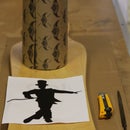Introduction: Vacuum Bending Skateboard Veneers
This is a step-by-step tutorial showing DIY builders how to operate Roarockit's Thin Air Press (TAP) vacuum bag. The bags come in four different sizes to accommodate different sized projects:
14" x 47" (small and preshaped skateboard veneers)
20" x 70" (large custom skate/longboards)
26" x 28" (small woodworking projects)
36" x 52" (large woodworking projects and wakeskates)
Using the TAP bag is the same whether you are building custom skateboards or bending larger furniture pieces. This tutorial should help give you a basic idea of how to operate the vacuum bag and use it for your own projects.
**note** vacuum bagging has been used for many years in different industries, and there are other options on the market. This tutorial is specific to the Roarockit Skateboard Company's Thin Air Press vacuum bag system.
NOW LET'S BUILD A SKATEBOARD!
Step 1: Tools & Materials
To laminate and bend the skateboard veneers you will need the following.
Tools:
Thin Air Press (TAP) vacuum bag
TAP manual hand pump
Breather Netting (used to help evenly evacuate air from the bag)
Glue Roller (with plastic bag for storing)
Materials:
1/16" Skateboard veneers (for this tutorial we are using 7 layers of Canadian Maple)
Masking Tape
Foam Mold (check our Instructable on how to create one)
Glue (we highly recommend Titebond III for its waterproof properties and open dry time)
Optional:
Some sort of shop apron to protect your clothes from glue...which does NOT wash off!
Step 2: Veneer Prep
Before you start gluing your veneers, you will want to make sure that you have everything needed around you. This will help prevent any last minute running around while the glue is drying... trust me, make a mental checklist before starting!
Layout your veneers in the order you want them laminated. Cross grain veneers are an essential part of any skateboard deck construction, and there should always be two Cross grain layers evenly distributed throughout your board. There are no hard and fast rules as to what order they should be in, and different combinations will make for a unique feel and ride. The amount of layers used in your board will also be a factor when deciding the order of veneers.
In this particular build we will be laminating a 7 layer board made with 1/16" Canadian Maple. The Long and Cross grain veneers are laid out:
Long
Long
Cross
Long
Cross
Long
Long
Another great tip before you get started is to alternate the 'cup' in your veneers. This will help prevent warping over the life of your board.
Step 3: Glue Up
When you have all of the necessary tools and materials together, and have put the veneers in the order they will be laminated, you are ready to start rolling on the glue. We suggest using a short-napped roller for evenly distributing the glue. It is very important to have a consistent coating of glue in between each layer so it will dry evenly and prevent bubbles from forming.
** When the veneers absorb too much glue in between layers, the moisture can cause swelling in the affected area. If there is not enough glue, it will form weak points of contact between veneers and cause the dreaded...DELAMINATION!
If you are using a brand new glue roller, you will want to 'juice' it with glue before trying to apply it to your veneer. A fresh roller will soak up a lot of glue before it starts distributing it to your project. To avoid this problem, use the roller on a scrap piece of material and let it absorb glue until it looks fully coated. With Titebond III you can easily store your glue roller in an air tight bag, which will keep it wet until your next build. For this build, we used an old roller that had already been stored in a bag.
Titebond III is our glue of choice because it is cost effective and has some properties that are ideal for skateboards. It is waterproof and flexible when dry, which is perfect for not cracking in between layers when your board flexes. It also has one of the longest open dry times of any wood glue, which helps give you more time to get your project in the bag once you have started gluing your veneers (about 9-10 minutes).
Once you start pouring and rolling the glue, you will want to work quickly and make sure that you cover the entire surface on both sides of each veneer (minus the two outside layers of course). With some experience, you will get used to how much glue is needed on each layer of veneer to totally cover the surface, which is why we are pouring from the bottle without measuring. On a veneer sheet this size (9.5" x 34") it will take approximately 2-3 oz of glue to adequately cover the surface.
After all 7 layers have been glued, you can store your roller in the plastic bag and get your project ready to put in the TAP bag.
Step 4: In the Bag
It is time to align your veneers onto the mold and put the project into the TAP bag!
For this step you want to make sure that your veneers are sitting where you want them on your mold. Take a second to line up any edges that may have shifted in the gluing process and place the veneers centered on your mold. You can help prevent the veneers from moving around further by taping them in a bundle or to your mold itself.
* Remember, you are still on the clock until your project has been sealed in the bag...work quickly!
Start sliding your project into the bag from the one open end. Keep the brown backed strip on your sealing tape until the project is fully inside the bag. This will help prevent your sealing tape from getting dirty which can cause leaks in the seal.
Once your project is fully inside the bag, place the breather netting strip under the valve of your bag. This will help prevent the valve from sticking right to the surface of your project and allow the air to evacuate evenly when you start pumping. When you have the breather netting set, you can peel the backing off your sealing tape and start to press it down firmly to both sides of the vinyl bag.
* We suggest throwing the brown backing strip into the bag so you do not lose it! You will need it to keep your sealing tape clean over multiple pressings.
It is important to inspect the sealing tape for any breaches that may allow air into your bag. You can visually inspect the black tape for greyish looking areas that may not be fully adhered to the vinyl. The corners of the bag is another area that is worth inspecting to make sure the tape is really pushed into the vinyl. The majority of leaks in bags will come from the sealing tape.
Step 5: Evacuating Air From the Bag
Once your project is in the bag and fully sealed, you can use the hand pump to start evacuating air from the bag.
The manual hand pump is a low volume-high pressure pump that is simple to use and very effective. Depending on where you are above sea level, it can provide approximately 13psi which is more than enough to bend your veneers to the desired shape.
Check out this link for a great lesson on vacuum pressures
To operate the hand pump, simply place it over the grey valve on your TAP bag and slide it up and down. If you have a proper seal at the end of your bag, you will notice the vinyl start to shrink almost immediately. Keep pumping until you feel the pressure get stronger in the pump itself. When all of the air has been evacuated from the bag, the pump will make a 'clicking' sound to let you know.
At this point it is a good idea to inspect the edges of your project to see if the veneers have bent to the shape of your mold. You may notice that the vinyl has slipped in between your bottom layer of veneer and the mold itself. This can prevent the veneers from taking on the full shape of your mold, but can easily be fixed. Simply grab the edge of the vinyl TAP bag, and pull it out from in between the veneers and the mold. If you find that it is too hard to pull out, you can take the cap off of the valve for a second to release some air and pull out the vinyl before re-pumping the bag. You will notice that once you pull the caught vinyl out, the veneers will be pulled down further to the shape of your mold. Go around the entire project doing this to make sure you have a strong and accurate lamination.
Step 6: Finishing Up
After you have achieved a a full seal in your bag, it is a good idea to check it every once and a while to make sure there are no leaks. come back in 10-15 minutes and re-pump the bag to see if it has lost any pressure. If not, you should be able to walk away from the project and let it dry the suggested 8 hours (usually overnight).
*even though glue dry times say around 2 hours for projects, because there is no air in the bag it drastically slows down the dry time. We strongly suggest at least a full 8 hours in the bag for a project with bends like this.
If you do notice that your bag has lost pressure over time, the first thing we recommend is double checking your sealing tape. You can also remove the valve cap and make sure there are no dust particles preventing an air tight seal on your valve itself. Give the under side of the valve a quick wet wipe, put it back in place and re-pump the bag. Keep checking your bag to see if it is still losing pressure. If the leak continues, but is slow, you may have a small hole in your bag somewhere. If you can find where the hole is, usually by a visual inspection or hearing a leak, you can simply put some clear packing tape over the area which should work as a temporary fix.
Worst case scenario, you have a hole in your bag that you cannot find while your project is glued and drying. There are easy ways to find leaks and maintain/repair a TAP bag when there is no project inside, but in this scenario you may be forced 'babysit' your bag for a while and keep re-pumping the seal. Depending on how bad the leak is, you may only have to give the bag a pump every couple hours with a slow leak.
*a good way to prevent a project from being laminated in a bag with a leak is to do a dry run. If you put the project in the bag without any glue beforehand, you can evacuate the air and see if it holds a seal. If it doesn't, you now have an opportunity to find the problem and fix it without risking your freshly glued veneers.
After a minimum of 8 hours in the bag, your project should be ready to take out, cut to your desired shape, sand and finish! I will be making another tutorial for that part of the process as well :)
Check out the next steps on our new Instructable here - https://www.instructables.com/id/Layout-Cut-and-Finish-a-Skateboard/













